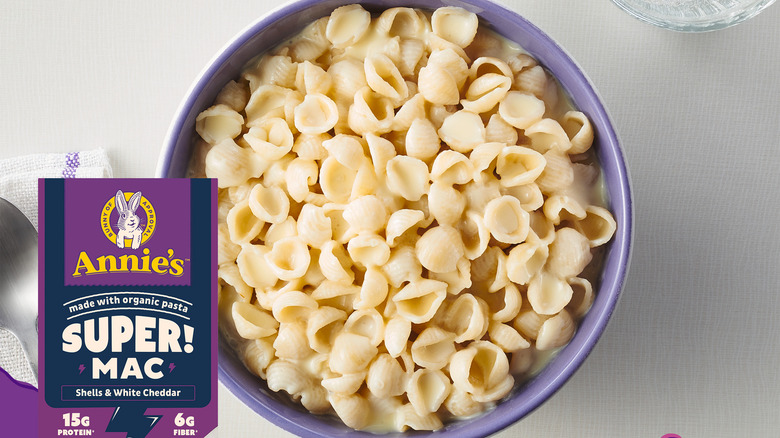Annie's New Mac And Cheese Is Full Of Protein (Are We All Still Chasing Gains?)
If you have children — or you just really love nostalgic kids' foods — you're probably familiar with the brand Annie's Homegrown, which makes nutritious, organic versions of staple favorites like pasta, fruit-flavored gummies, and snack crackers. The company was founded in 1989 by Annie Withy, who (according to the company website) wanted to create "a socially conscious and successful business." Decades later, Annie's Homegrown is still in the game, taking ubiquitous foods and making them sustainably with quality ingredients. One of the company's best-selling products is boxed mac and cheese. There are several varieties, including a classic macaroni pasta with yellow cheddar sauce, a shell pasta with white cheddar sauce, a gluten-free version made with rice pasta, and mac and cheese with Disney-inspired pasta shapes.
When Annie's Homegrown got its start back in the late '80s, low-fat diets were still all the rage, and few folks worried about carbs. But these days, pasta gets the side-eye from many who are looking to boost their protein intake and limit carbs. While kids still seem mostly amenable to pasta dinners, protein is now in the spotlight, and everyone wants more of it. Annie's Homegrown has been listening. While the company hasn't abandoned its original mac and cheese lineup, it is now offering a new version: Super! Mac. This product is a shell and cheese pasta that ups the ante by supplying 15 grams of protein as well as 6 grams of fiber, so kids (and adults) can get their protein without needing a side order of chicken nuggets.
Alternate pastas for kids and adults alike
While high-protein pasta is a new venture for Annie's Homegrown, the company is no stranger to accommodating allergies and dietary restrictions. It already produces a wide range of boxed mac and cheese items, providing options for those with restricted diets. Included in the brand's classic boxed macaroni lineup are the aforementioned gluten-free options, reduced sodium mac and cheese made with grass-fed cows' milk, and even vegan macaroni.
Balancing the carbs in pasta with higher-protein sauces and toppings has long proven popular with diners – traditional Bolognese sauce is one such example — but the move toward creating dried pasta with a higher protein content is a relatively recent one, having taken off in the last decade or so. Pasta is traditionally made with durum wheat, which has a high protein content compared to other kinds of wheat, but it still doesn't yield a protein-dense finished product.
Increased awareness surrounding food allergies and gluten-free diets has prompted a growing movement to create pastas made with alternative flours and ingredients. Even Italy's largest dried pasta manufacturer, Barilla, is in on the game, having created a pasta that incorporates plant proteins (from chickpeas, peas, and lentils) into the process. As with all things gastronomy-related, though, it's a matter of balancing nutrition and taste.

